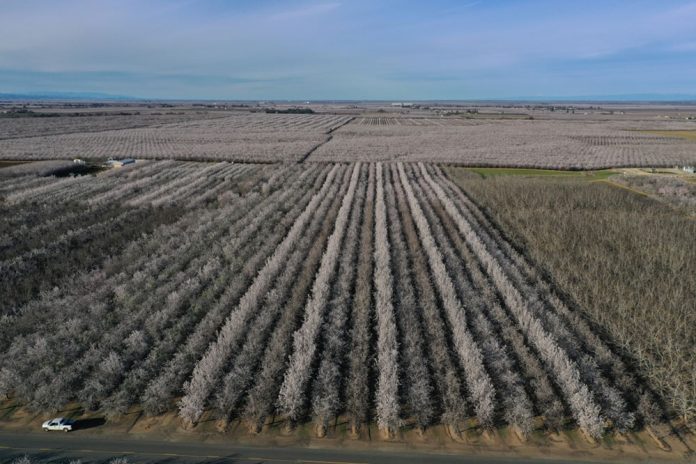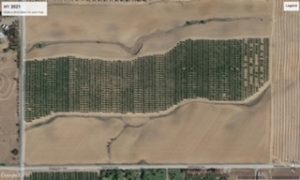
With 2023 almost here, many nut crop growers face another challenging year. Nut prices remain low and costs of essential inputs (water, fertilizer, pesticides, etc.) are up. With net return to grower the measure of successful farming, the targets of consistent, solid yields and minimal costs to sustain those yields are crucial grower goals. What varieties, rootstocks and practices deliver on these goals against downward pressures from changing weather, pest and market pressures? Experience, research results or a combination of both guide the best possible decisions. California tree nut growers and their advisors especially need research results to face new challenges where little to no experience exists.
Nickels Soil Lab is a field research facility and an important resource for the California tree nut industry. Established through the bequest of Leslie J. Nickels, the Nickels Soil Lab (NSL) is a 160-acre, private commercial farm operated for the public good by the Leslie J. Nickels Trust. In collaboration with University of California the Colusa Water District and the University of California, NSL has hosted dozens of research projects, delivering real contributions to the knowledge base of California nut growers since the early 1970s. The annual spring field day at NSL highlights the research done there. Here are some of the research questions and highlights of the past 30 years and potential beneits to growers.
Can microirrigation deliver good almond production?
In 1991, a 20-acre trial comparing tree growth and crop yield under microsprinklers, double-lined drip, single lined drip or buried drip irrigation was planted at NSL. Varieties were Nonpareil, Carmel, Monterey and Butte on Lovell rootstock. Microsprinkler irrigation grew slightly bigger trees compared to surface and buried drip while crop yield was not significantly different all but a few years for vigorous varieties. Both microsprinklers and surface drip delivered good production (average of 2200 to 2400 kernel/lb per acre) by 7th-leaf on the less vigorous (Class 2-3) soils of the Arbuckle region.
Is commercial walnut production feasible on Class 2-3 soil?
In the 1980s, most walnut acreage was on deep well-drained soil along major rivers. There was no history of successful walnut production in the older soils along the valley edges. In 1986, John Edstrom, UCCE farm advisor for Colusa County and NSL manager/researcher from 1984 to 2010, planted two acres of Chandler walnuts on Paradox seedling or northern California black walnut rootstocks. Success of the Paradox rooted trees helped encourage development of other plantings on similar sites in the Central Valley.
What happens to almond production and tree health when trees are not irrigated for a year?
Research led Dr. Ken Shackel (UC Davis) tracked tree health and production in mature almonds at NSL previously well irrigated but not irrigated for an entire season (2009). Major crop loss for two years (2009 and 2010) resulted from that single year of water stress. In 2009, nut set was good and crop loss was mostly due to smaller nut size compared to nuts from well-watered trees. However, extreme water stress in 2009 reduced flower buds developing for the next spring. So, despite full irrigation in 2010, only a small crop was harvested that year due to much fewer flowers and fewer nuts resulting from the water stress the year before. The trees generally survived the extreme water stress and returned to good production the third year of the study under good irrigation practices.
If needed, can fall boron sprays increase yield?
Following up on work by Dr. Patrick Brown’s lab at UC Davis, trials at Nickels in 1995-97 consistently showed increases in almond yield of 150 to 400 kernel lb/acre from a single fall foliar spray of 3 lbs/acre of Solubor equal to 0.6 lbs actual boron/acre. Use of surface water for irrigation containing almost no boron plus 15 inches of winter rain leaching boron from the root zone soil were the primary contributors to the low boron levels of these trees.
Do you need annual pruning to get good, long-term production in almonds and walnuts?
No. Trials at NSL in almonds and walnuts show no production benefit from annual pruning after the first dormant pruning.
Almond orchards on what rootstocks last longer?
Peach/almond hybrids (Hanson, Brights, Nickels) and intraspecific hybrid (Viking) rootstocks delivered superior anchorage, tree survival and cumulative Nonpareil yield in a trial planted by John Edstrom and Stan Cutter (NSL farm manager since 1995) in 1997. Standing trees still yield well in the 26th leaf, but production per acre suffers where more trees are missing. In this trial, Lovell and Nemaguard seedling rootstocks and Atlas intraspecific hybrid lost more trees and production than the “winners” listed above.
Does fall nitrogen fertilization pay (deliver positive return on investment) in almond orchards?
Not in a 3-year trial at Nickels in a productive orchard with adequate July leaf nitrogen (N) levels (>2.4% N). Adding postharvest N (30 to 60 lbs N/acre in September or October) didn’t increase yields the following year. Based on these results and with UN32 at $800/ton ($1.25/lb N), not fertilizing almonds with N in the fall could save $35 to $75 per acre without changing yield.
What pollinizer varieties deliver the best overall returns when planted with Nonpareil?
In a 50% Nonpareil; 25% Pollinizer A; 25% Pollinizer B planting by John Edstrom and Stan Cutter in 2006, pollinizer production was the key to the best returns allowed by the weather. Pollination combos compared included Monterey/Fritz, Aldrich/Winters or Winters/Monterey varieties, all on Lovell seedling rootstock under double-lined drip. Differences in adjacent pollinizer varieties did not influence Nonpareil yield, but Monterey and Winters produced greater cumulative yields than Fritz or Aldrich. Fritz and Aldrich are not poor producers, but occasional off-years for those varieties made the difference in cumulative yield compared to more consistent production from Winters and Monterey.
In the Sacramento Valley, does a solid Independence planting produce better yields and income than a high-value (75% soft shell) Nonpareil planting of 50% Nonpareil, 25% Sonora and 25% Aldrich?
It depends on the year. In a 2013 planting (15’ x 20’) on Viking rootstock under double-line drip irrigation, highest annual gross income “winner” between the two plantings split 50:50 from 2018-21 (6th to 9th leaf) with the Independence planting coming out on top in 2018 and 2021 and the Nonpareil/pollinizer planting in 2019 and 2020. This split occurred despite the smaller tree size of Independence at this site compared to Nonpareil and Sonora. Consistent Independence production and highly variable Sonora yields have been the major factors in comparing production and value in this planting.
Questions Driving Recent and Current Trials
Does a higher density almond planting improve production and grower income? In a trial planted in 2017, differences in down-the-row tree spacing (12’, 14’, 16’ or 18’ all with 21’ row spacing) on vigorous (Titan) or moderately vigorous (Rootpac-R) rootstocks under double-lined drip produced no significant yield differences within each rootstock, but trees were smaller at the closer row spacings. The original almond tree spacing trial, planted by UCCE Stanislaus County Advisor Roger Duncan in 2000, produced similar results early in the orchard life. In Roger’s trial, yield per acre shrank in the wider-spaced trees compared to the closer-spaced trees as the orchard aged.

Can organic practices maintain almond production over time?
An organic almond demonstration orchard planted at Nickels by John Edstrom and Bill Krueger in 2006 (Nonpareil and Fritz on Lovell rootstock at 16’ x 22’ with buried drip irrigation) addresses this question. Annual production runs 60% to 80% of that from a conventionally farmed (identical layout) orchard planted at the same time. Weeds control is by propane flaming and foliar diseases by organic fungicides. Managing root intrusion in the buried drip emitters and maintaining good nitrogen nutrition are now the major challenges.
Does spray volume (gallons per acre) make a difference in navel orangeworm (NOW) control?
Yes. Results of large-scale trials by Joel Siegel (USDA) and Matt Strmiska (formerly with Adaptiv in Fresno, now with EE Muir, Australia) showed that 200 GPA delivered better coverage and NOW control than 100 GPA. Research at Nickels showed similar results, especially in high worm (NOW) pressure years. Low-drift nozzles delivered similar NOW control as standard hollow cone nozzles at the higher spray volume.
Questions Driving Recent Long-Term Projects
Does applying phosphorus fertilizer improve almond production?
Can new rootstocks improve walnut orchard health and production compared to Paradox clones already in the market?
How does chipping and incorporating the old orchard (Whole Orchard Recycling) affect tree health and crop production in the next orchard? Do the chips change how the orchard grows with or without preplant fumigation to control nematodes and replant disorder?
That’s a quick overview of past and current projects at NSL. Directions for future research include evaluating new planting schemes, rootstocks, varieties and farming practices to maintain positive net grower returns under rising input costs and market expectations. These new plantings, just in the planning stage now, should continue to deliver valuable information to the California tree nut industry and maintain the status of the Nickels Soil Lab as a valuable asset for California agriculture.
Since 2015, The Leslie Nickels Trust has invested in new almond orchards and irrigation infrastructure* at NSL to best face an uncertain (weather, markets, water, etc.) future. There are new orchards with salt-tolerant rootstocks and high-value varieties as well as functioning wells. Older orchards with missing trees will be pushed out this winter to cut costs and improve overall returns.
However, the short-term economic future for NSL is uncertain. For years, careful management, timely big-ticket support*, good surface water availability and generally good prices have kept Nickels in the black despite higher costs of operating small (2 to 20 acres) research plots compared to larger blocks commonly farmed by growers. Nickels budget is now in the red. On top of that, NSL doesn’t qualify for crop insurance due to the use of unproven farming practices (research). NSL could use your help. Please consider a donation to support Nickels Soil Lab at myaglife.com/fundraiser/. All proceeds go directly into the NSL trust account to maintain the facility.
*The Almond Board of California supports major water projects at NSL, including new mainlines, well repair, etc., that NSL cannot cover. This has been particularly true in the last two years.
















